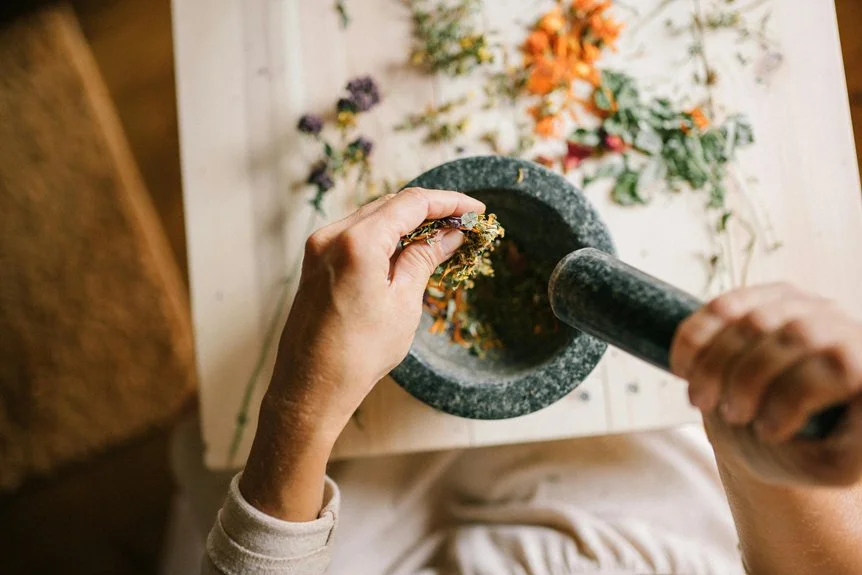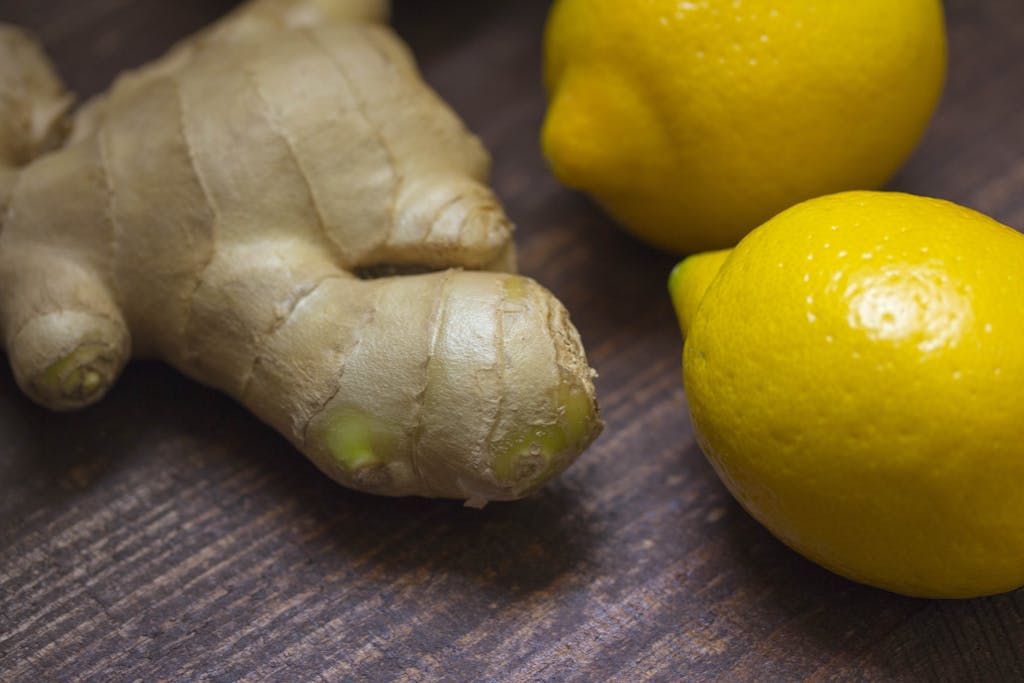
In all likelihood, you have spent more money on over-the-counter medications this year than you would care to acknowledge, and truthfully, half of them did not even work particularly well. I understand – when grappling with joint discomfort, queasiness, or those bothersome cold symptoms, you will try anything for alleviation. But the reality is: your kitchen pantry and spice rack may already contain some remarkably efficacious remedies that could spare you both financial outlay and visits to the pharmacy.
Key Takeaways
- Turmeric containing curcumin reduces arthritis inflammation as effectively as ibuprofen when consumed daily for 4-8 weeks.
- Ginger tea works as well as prescription anti-nausea medications for morning sickness, motion sickness, and chemotherapy-related nausea.
- Peppermint activates anti-pain channels and reduces IBS symptoms including bloating, cramping, and abdominal pain through muscle relaxation.
- Eucalyptus oil steam inhalation with 3-5 drops helps clear nasal congestion by thinning mucus and opening airways.
- Shiitake mushrooms boost immune system function through lentinan compounds when consuming 5-10 grams daily for four weeks.
1. Turmeric for Arthritis and Joint Pain
Countless people wake up every morning feeling like their joints have been replaced with rusty hinges, and if you’re one of them, turmeric might become your new best friend. This golden spice packs curcumin, a powerhouse compound that tackles arthritis inflammation head-on. Studies prove it’s as effective as ibuprofen, but without your stomach staging a revolt.
You’ll want to consume half to one-and-a-half teaspoons daily, and here’s the kicker – sprinkle some black pepper on top. It sounds weird, but pepper dramatically boosts curcumin absorption. Think of it as turmeric’s wingman.
Within four to eight weeks, you should notice real relief. Ancient Ayurvedic practitioners figured this out 4,000 years ago, so you’re in good company. Remember that continuous effort is the path to progress, so consistency with your turmeric routine will be key to achieving lasting results. Sometimes the best solutions hide in your spice rack.
2. Capsaicin From Chili Peppers for Topical Pain Relief
Why reach for expensive pain creams when your kitchen cabinet holds a fiery solution that’s been soothing aches for centuries? Capsaicin from chili peppers packs serious pain-fighting power that’ll make you wonder why you’ve been overlooking this spicy superhero.
I’ve used capsaicin for muscle soreness, and honestly, it’s like having a personal heat therapist in a jar. The compound tricks your nerves by creating initial heat, then numbing the area completely. You can make your own potent cream by mixing three tablespoons of cayenne powder with one cup of coconut oil – way cheaper than prescription patches containing 8% capsaicin.
For an even more therapeutic approach to muscle pain, try soaking in Epsom salt baths enhanced with warming essential oils like ginger and black pepper that complement capsaicin’s heat-based relief.
Just bear in mind, this isn’t gentle lavender we’re talking about. Keep it away from your face and eyes unless you want an unforgettable lesson in Home Remedies gone wrong.
3. Ginger Tea for Nausea and Inflammation

Most mornings when I’m feeling queasy or my joints are acting up like rusty door hinges, I skip the medicine cabinet and head straight for my ginger stash. Individuals have likely heard ginger tea can tackle nausea, but this stuff’s basically nature’s prescription medication without the side effects.
Works as well as prescription anti-nausea meds after surgery
Crushes morning sickness, motion sickness, and chemo-related queasiness
Contains gingerol compounds that fight inflammation naturally
Safe to drink 1-4 times daily without worry
Tastes amazing with honey, lemon, or cinnamon
I grate 1-2 teaspoons of fresh ginger per cup, steep it for ten minutes, and honestly? It’s like having a pharmaceutical company growing in your kitchen. Many independent bookstores have discovered that offering herbal teas like ginger creates community connections that go beyond just selling books, turning their spaces into wellness hubs where people gather to discuss natural remedies.
4. Shiitake Mushrooms for Immune System Support
While ginger works wonders for immediate discomfort, I’ve learned that building long-term defenses requires something with more staying power—and that’s where shiitake mushrooms come in. These powerhouse fungi contain lentinan, a compound that’ll transform your immune system into a fortress. I consume 5-10 grams daily for four weeks straight, and honestly, it’s like giving your body its own personal army.
The secret weapon here is lentinan’s ability to inhibit cancer cells while boosting your natural defenses. I toss chopped shiitakes into my bone broth—two immune-boosting remedies in one bowl. This approach falls perfectly under Complementary and Alternative Medicine, giving you control over your health destiny. Your immune system deserves this upgrade, and shiitakes deliver results you can actually feel.
For an extra immune boost, I’ll add shiitakes to my morning protein smoothie alongside spinach and banana—creating a nutrient-dense breakfast that supports both energy and immunity.
5. Eucalyptus Oil for Respiratory Congestion
You have likely stuffed tissues up your nose during a nasty cold, wondering if there’s anything better than waiting it out. Eucalyptus oil can actually help clear those stubborn sinuses through simple steam inhalation, though you’ll need to follow some important safety rules first.
I learned this the hard way after nearly giving myself a chemical burn, so let’s talk about doing steam treatments safely and what precautions you can’t skip. A professional-grade facial steamer with eucalyptus essential oil addition can deliver nano-sized steam particles for more effective weekly deep cleansing treatments that elevate your entire respiratory care routine.
Steam Inhalation Methods
When your sinuses feel like they’re packed with concrete and breathing through your nose seems impossible, eucalyptus oil steam inhalation can be your respiratory rescue mission. Essential oils like eucalyptus contain 1,8-cineole, which works like nature’s morphine for your airways, helping thin that stubborn mucus and opening your nasal passages.
Add 3-5 drops to a bowl of steaming hot water. Drape a towel over your head and lean over the bowl. Inhale deeply for 5-10 minutes. Add drops to a warm, wet washcloth for portable relief. Diffuse it in your shower for hands-free treatment.
Safety Precautions Needed
Before you turn your bathroom into a eucalyptus spa retreat, there’s some serious stuff we need to talk about first. You’ve got power over your health choices, but that means taking responsibility for safety precautions too.
If you’ve got asthma, eucalyptus oil can actually trigger attacks – not exactly the breathing relief you’re after. Got pets? This stuff’s harmful to them, so keep Fluffy away from your steam sessions.
Here’s where I learned the hard way: always dilute properly and never go overboard. Infants can experience respiratory distress from inhaling it, so family homes need extra caution.
Before starting any eucalyptus routine, chat with your healthcare provider first – they’ll help you use it safely.
6. Lavender for Migraines and Anxiety

If you’re dealing with pounding migraines or that anxious feeling that won’t quit, lavender might become your new best friend. This purple powerhouse doesn’t just smell amazing – it actually works to calm your nervous system and ease headache pain in ways that’ll surprise you.
Let’s explore how you can use lavender’s migraine-fighting abilities, its anxiety-busting properties, and the simple safety rules that’ll keep you feeling great instead of sorry. Taking time to prepare and use lavender remedies can become a meaningful self-care routine that helps you feel more centered and ready to tackle whatever comes your way.
Lavender’s Migraine Relief Benefits
While conventional migraine medications often come with a laundry list of side effects that make you question if the cure’s worse than the headache, lavender essential oil offers a gentler approach that actually works.
Studies prove that lavender oil delivers real migraine relief, matching acetaminophen’s effectiveness without the stomach issues. You can literally breathe your way to less pain, and honestly, that beats swallowing another pill.
Here’s what makes lavender your migraine-fighting ally:
- Reduces migraine frequency and severity through simple inhalation
- Tackles nausea and light sensitivity as effectively as over-the-counter meds
- Calms migraine-related anxiety and stress naturally
- Provides rapid relief when applied to temples or inhaled during attacks
- Decreases dependency on conventional medications over time
Just dab some on your temples or take a few deep breaths when that familiar throb starts.
Anxiety Reduction Properties
Lavender doesn’t just tackle your migraines – it also works double duty on the anxiety that often triggers them in the first place. You know that familiar spiral where stress builds up, your shoulders tense, and boom – headache city. Well, lavender steps in like your personal bodyguard against anxiety.
Studies back this up, showing lavender genuinely helps calm your racing mind and relax your body. You’ve got options here: sip some lavender tea during your afternoon slump, or keep a small satchel in your desk drawer for those “Monday morning panic” moments. The scent alone can dial down your stress levels within minutes. It’s like having a portable chill pill that actually works, minus the side effects and doctor visits.
Safe Usage Guidelines
Something important comes before you start dousing yourself in lavender oil like it’s the fountain of youth – you need to know how to use it safely. These home remedies can backfire if you’re not careful, and trust me, you don’t want to turn your relaxation routine into a hormone nightmare.
Here’s your power-user safety checklist for tackling health conditions with lavender:
- Always dilute essential oil before applying to skin (carrier oils are your friend)
- Never ingest undiluted lavender oil – it can mess with your hormones
- Start with lavender tea or sachets for beginners
- Combine with sage and rose oils for enhanced PMS relief
- Stop immediately if you experience skin irritation or unusual symptoms
Smart usage means effective results without the drama.
7. Wintergreen Mint for Muscle and Joint Pain
That nagging ache in your shoulders after a long day at the computer, or the stiffness in your knees when you get out of bed – we’ve all been there, and it’s downright frustrating. Wintergreen mint might be your secret weapon for taking control of muscle and joint pain without reaching for over-the-counter pills.
This powerhouse contains methyl salicylate, which creates an initial burning sensation before delivering that sweet numbing relief. You’ll want to dilute the essential oil before applying it directly to problem areas.
| Application Method | Dilution Ratio |
|---|---|
| Light muscle soreness | 2-3 drops per tablespoon carrier oil |
| Moderate joint pain | 4-5 drops per tablespoon carrier oil |
| Arthritis relief | 5-6 drops per tablespoon carrier oil |
| Post-workout recovery | 3-4 drops per tablespoon carrier oil |
| General maintenance | 1-2 drops per tablespoon carrier oil |
Use home remedies like wintergreen responsibly – high doses can be toxic, especially around kids. When applying topical treatments, gentle scalp massage techniques can help improve circulation and enhance the absorption of beneficial compounds into the affected areas.
8. Peppermint for Digestive Issues and IBS
If you’re dealing with IBS and feel like your digestive system’s plotting against you, peppermint might become your new best friend. This cooling herb works by activating specific anti-pain channels in your body, which helps calm those awful spasms and reduces the cramping that makes you want to curl up in a ball.
I’ve found that peppermint oil, when taken properly, can substantially/considerably/markedly cut down on the bloating, diarrhea, and abdominal pain that turn simple meals into digestive nightmares. For additional digestive support, you can create a soothing minty beverage by combining fresh mint leaves with green tea and lemon juice for a refreshing spritzer that may help ease stomach discomfort.
IBS Symptom Relief
Dealing with IBS can turn your digestive system into an unpredictable rollercoaster, but peppermint might just be the gentle brake you’ve been searching for. Peppermint oil works by activating anti-pain channels in your body, giving you real control over those frustrating symptoms that derail your day.
Research shows peppermint oil effectively tackles the main irritable bowel syndrome troublemakers:
- Abdominal pain and cramping
- Unpredictable diarrhea episodes
- Uncomfortable bloating
- Digestive spasms
- Overall gut discomfort
You can sip peppermint tea throughout the day or take enteric-coated capsules for targeted relief. Studies suggest combining peppermint with fiber creates an even more powerful defense system. While peppermint’s generally safe, always check with your healthcare provider first, especially if you’re taking other medications.
Anti-Pain Channel Activation
Peppermint’s secret weapon lies in its ability to flip a biological switch that literally turns down your pain signals, and honestly, understanding this mechanism changed how I think about natural remedies entirely. When you use peppermint oil for IBS, it activates specific anti-pain channels in your gut, which basically tells your digestive system to chill out and stop cramping.
| Before Peppermint | During Treatment | After 4 Weeks |
|---|---|---|
| Sharp cramping daily | Gentle cooling sensation | Reduced pain episodes |
| Unpredictable spasms | Muscle relaxation begins | Better control |
| Constant discomfort | Gradual relief | Improved quality |
| High pain levels | Manageable symptoms | Significant improvement |
| Limited activities | Increased confidence | Normal routine |
This isn’t just wishful thinking—peppermint oil inhibits calcium channels, stopping those painful intestinal contractions that make IBS miserable.
9. Fenugreek for Blood Sugar Management
The ancient spice sitting in your kitchen cabinet might actually be your secret weapon against stubborn blood sugar spikes. Fenugreek isn’t just another trendy supplement – it’s a powerhouse that puts you back in control of your glucose levels.
Here’s what makes fenugreek your blood sugar ally:
- High fiber content slows sugar absorption naturally
- Improves insulin function without harsh side effects
- Proven effective in multiple diabetes studies
- Available as seeds or convenient extracts
- Generally safe with minimal risks
You can consume fenugreek seeds regularly or opt for standardized extracts if you’re serious about managing type 2 diabetes. The fiber works like a gentle brake on your blood sugar roller coaster, giving your body time to process glucose properly. Just consult your doctor first, especially if you’re already taking medications.
Many health practitioners who start nutritional coaching businesses find that recommending evidence-based natural remedies like fenugreek helps their clients achieve better health outcomes.
10. Magnesium-Rich Foods for Stress and Relaxation
When life feels like it’s spinning out of control and your stress levels are through the roof, your body might be crying out for one simple mineral you’re probably not getting enough of. Half of Americans aren’t hitting their daily magnesium targets, and that deficiency could be sabotaging your chill.
Magnesium literally powers your body’s relaxation response, switching on that parasympathetic nervous system that helps you unwind. Think of it as your internal stress-fighting superhero.
| Magnesium-Rich Foods | Stress-Fighting Benefits |
|---|---|
| Dark chocolate | Boosts mood, reduces cortisol |
| Spinach | Supports nerve function |
| Almonds | Promotes better sleep |
Loading up on these foods isn’t just about stress management—you’re also supporting muscle function, blood sugar regulation, and immune health. For those watching their carb intake, magnesium-rich options like dark chocolate can satisfy your sweet tooth while supporting your body’s natural relaxation response.
11. Honey for Cough and Sore Throat

When you’re dealing with that annoying nighttime cough that keeps everyone awake, you’ll be amazed at how effective a simple spoonful of honey can be as a natural cough suppressant. I’ve found that honey works just as well as those expensive over-the-counter cough syrups, plus it actually tastes good instead of like medicine cabinet regret.
The best part is that honey’s antimicrobial and anti-inflammatory properties don’t just quiet your cough, they also coat and soothe your scratchy throat naturally.
Natural Cough Suppressant
While I’ve spent countless nights listening to my kids hack away like tiny lumberjacks, I discovered that honey works just as well as those expensive cough syrups – and it’s probably already sitting in your pantry.
Here’s what makes honey your secret weapon against coughs and sore throat:
- 2 teaspoons before bedtime reduces nighttime coughing frequency
- Thick consistency coats and soothes irritated throat tissues
- Contains gluconic acid and hydrogen peroxide that suppress cough reflexes
- Antimicrobial properties help fight underlying infections
- Works for children over 1 year old (never give to infants)
You’ll save money while actually getting better results. The viscosity creates a protective barrier in your throat, while those natural compounds actively work to calm your cough reflex. It’s like having a pharmacy in your kitchen cabinet.
Throat Soothing Properties
Beyond just stopping those relentless coughing fits, honey transforms into your throat’s best friend by creating a protective layer that actually heals while it soothes. You’re fundamentally giving your irritated throat a golden armor that fights inflammation while coating every scratchy surface.
| Honey’s Healing Powers | What It Does for You |
|---|---|
| Antimicrobial compounds | Kills bacteria causing irritation |
| Thick, viscous texture | Coats and protects raw throat tissue |
| Natural antioxidants | Reduces swelling and inflammation |
| Soothing properties | Calms scratchy, painful sensations |
| Anti-inflammatory agents | Speeds up healing process |
Mix a tablespoon into warm tea, and you’ll feel that instant relief washing over your throat. Studies prove honey works just as well as store-bought cough suppressants, giving you natural power over your symptoms.
12. Salt Water Gargle for Throat Irritation
Countless people have discovered that one of the simplest remedies for a scratchy, painful throat sits right in their kitchen cabinet. You don’t need fancy medications when salt water can work its magic on your irritated throat.
This powerful gargle delivers multiple benefits that’ll help you reclaim control over your discomfort:
- Reduces swelling and inflammation in throat tissues
- Kills bacteria and viruses with natural antiseptic properties
- Temporarily numbs pain for immediate relief
- Loosens stubborn mucus and phlegm buildup
- Provides safe, cost-effective treatment without side effects
Mix half a teaspoon of salt into eight ounces of warm water, gargle for thirty seconds, then spit it out. The warm temperature enhances the salt’s healing properties, giving you fast-acting relief that actually works.
13. Steam Inhalation for Nasal Congestion
When your stuffy nose makes you sound like you’re talking through a pillow, steam inhalation becomes your best friend for clearing those clogged passages. You’ll dominate nasal congestion by leaning over a hot bowl of water for 5-10 minutes, letting that steam work its magic on your sinuses.
Want to kick it up a notch? Add a few drops of eucalyptus or peppermint oil to turn your steam session into a sinus-clearing powerhouse. Your shower works too – just crank up the heat and breathe deeply.
You might need multiple sessions throughout the day to stay clear. Just don’t go overboard with scorching steam, or you’ll irritate your airways instead of helping them.
14. Chamomile Tea for Upset Stomach

While steam works wonders for your head, your stomach might be staging its own rebellion down below. When you’re doubled over wondering why you trusted that leftover pizza, chamomile tea becomes your digestive superhero. This gentle home remedy doesn’t just taste pleasant—it actively fights your upset stomach with anti-inflammatory compounds that calm irritated gut tissues.
Chamomile’s benefits include:
- Reducing nausea and vomiting episodes
- Relaxing stomach muscles to ease cramping
- Stimulating digestive juices for better processing
- Preventing constipation naturally
- Providing anti-spasmodic relief from discomfort
I’ve found that brewing a strong cup and sipping slowly works best. The warm liquid soothes while chamomile’s natural compounds get to work repairing your digestive chaos.
15. Aloe Vera for Burns and Skin Irritation
Sometimes it feels like your skin has a personal vendetta against you—whether you’ve gotten too friendly with a hot pan, spent too long worshipping the sun, or brushed against something that left you looking like a lobster.
Here’s where aloe vera becomes your skin’s best friend and your secret weapon for taking control.
Cut open a fresh aloe leaf, scoop out that clear gel, and apply it directly to burns or skin rashes. Studies show it reduces healing time for first-degree burns compared to conventional treatments, plus it’s got serious anti-inflammatory power. The cooling sensation hits immediately, giving you instant relief from pain and redness. Just test a small area first—some people do experience allergic reactions.
16. Tea Tree Oil for Fungal Infections
Your skin isn’t the only part of your body that can turn traitor—fungal infections love to set up camp in the warm, moist places where you’d least want uninvited guests. Tea tree oil becomes your secret weapon against these stubborn invaders, packing antimicrobial properties that’ll make fungal infections think twice about overstaying their welcome.
This powerful oil tackles common culprits like:
- Athlete’s foot between your toes
- Ringworm patches on your skin
- Toenail fungus that won’t quit
- Candida albicans overgrowth
- Various skin fungal infections
Simply dilute a few drops with carrier oil and apply directly to affected areas. You’ll start seeing results within days, but recollect—tea tree oil isn’t for internal use, and severe infections need professional backup.
17. Cranberry Juice for Urinary Tract Health

If you’ve ever dealt with the burning, urgent misery of a UTI, you’ll want to know about cranberry juice’s impressive track record for keeping these infections at bay. This tart, ruby-red drink isn’t just an old wives’ tale – it actually contains powerful compounds called proanthocyanidins that prevent nasty bacteria from sticking to your bladder walls like unwanted houseguests.
You’ll need to drink about 8-16 ounces of unsweetened cranberry juice daily to cut your UTI risk by up to 50%, though fair warning: the unsweetened stuff tastes like liquid disappointment mixed with hope.
UTI Prevention Benefits
When I first heard about cranberry juice preventing UTIs, I’ll admit I was skeptical – it sounded too simple to be true. But after diving into the research, I discovered that cranberry juice’s proanthocyanidins actually create a slippery barrier that stops E. coli bacteria from sticking to your bladder walls. It’s like Teflon for your urinary tract.
Reduces UTI risk by 33% in women with recurring infections
Contains proanthocyanidins that block bacterial adhesion
Works best at 8-16 oz of unsweetened juice daily
Prevents rather than treats existing infections
Backed by analysis of 24 scientific studies
You’re not just drinking tart juice – you’re arming yourself with a proven preventive weapon.
Active Compound Effects
Now that we’ve covered how cranberry juice prevents UTIs, let’s dig deeper into what makes these little red berries so scientifically impressive.
The real powerhouse here is proanthocyanidins, which sounds fancy but basically acts like your body’s personal bouncer. These compounds don’t mess around when it comes to E. coli bacteria, the troublemaker behind most urinary tract infections. They literally block bacteria from sticking to your urinary tract walls, which is pretty amazing when you think about it.
It’s like having microscopic security guards patrolling your system. I’ve seen studies showing these compounds can reduce UTI recurrence by up to 35% in some women. That’s real power you can actually feel working in your favor.
Dosage and Preparation
Getting the right amount of cranberry juice can feel like solving a puzzle, but I’ve figured out the sweet spot through plenty of trial and error. The dosage that works best is 8-16 ounces daily, and trust me, preparation matters more than you’d think.
Here’s what I’ve learned about maximizing your cranberry juice power:
- Choose juice with at least 27% actual cranberry content
- Skip the sugar-loaded versions that defeat the purpose
- Drink it consistently, not just when symptoms appear
- Pair it with extra water to amplify the flushing effect
- Consider supplements if the taste makes you cringe
I started with 8 ounces daily and worked up to 12 ounces, which became my personal sweet spot. The key is finding unsweetened versions and sticking with your routine religiously.
18. Licorice Root Extract for Cold Sores
Although cold sores always seem to pop up at the worst possible times—like right before that important date or work presentation—licorice root extract might just become your new best friend in fighting these pesky outbreaks. This traditional remedy packs compounds with antiviral properties that can actually tackle the herpes simplex virus head-on.
Grab a cotton swab, soak it in licorice root extract, and apply it directly to that tingling spot the moment you feel it coming. Hit that cold sore several times throughout the day, and you’ll likely see reduced severity and shorter healing time. While researchers are still studying its full effectiveness, countless people swear by this natural approach for taking control of their outbreaks.
19. Oatmeal Baths for Itchy Skin Conditions
When your skin feels like it’s staging a rebellion with relentless itching from eczema, psoriasis, or that unfortunate encounter with poison ivy, an oatmeal bath might be exactly what you need to restore peace. This isn’t just grandma’s old-fashioned remedy – it’s backed by solid science that’ll make you feel like a skincare genius.
Creates a protective moisture barrier on your skin
Contains anti-inflammatory compounds called avenanthramides
Includes beta-glucans that calm irritated skin
Forms colloidal particles when finely ground
Reduces inflammation while restoring natural moisture
Simply grind plain oats into powder, add to warm bath water, and soak for 15-20 minutes. You’ll emerge feeling refreshed and considerably less itchy.
20. Warm Compresses for Chest Congestion
That stubborn chest congestion can make you feel like you’re breathing through a straw filled with molasses, but a simple warm compress might be your ticket to relief. You’ll grab a damp washcloth, make it comfortably warm, and place it directly on your chest for 10-15 minutes. The warmth increases blood flow and soothes those irritated airways that’ve been making your life miserable.
I’ve found that repeating this warm compress treatment several times throughout the day really amplifies the mucus-loosening power. You can also use a heating pad or hot water bottle if washcloths aren’t your thing. For maximum chest congestion destruction, combine your warm compress with steam inhalation or over-the-counter decongestants – because why fight fair?
21. Probiotics for Digestive Balance
If your gut feels like it’s hosting a chaotic party where the wrong bacteria showed up and trashed the place, probiotics might be the bouncer you desperately need. These beneficial bacteria work overtime to restore order in your gut microbiome, giving you the digestive control you deserve.
Your gut houses trillions of microorganisms that directly impact your immunity and mental clarity. When you take charge with the right probiotic approach, you’re investing in serious health power.
I’ve watched probiotics transform people’s lives, especially those battling IBS or recurring diarrhea.
Consider these probiotic powerhouses:
- Yogurt with live cultures
- Fermented sauerkraut
- Kombucha drinks
- Kefir smoothies
- Quality supplements
Start with one source daily, then gradually increase your probiotic arsenal for maximum digestive dominance.
Conclusion
You’ve now got 21 solid options to try when you’re feeling rough, and honestly, that’s pretty empowering. I’ve used most of these myself over the years, and they’ve saved me countless trips to the pharmacy. Sure, you’ll still need real medical help for serious stuff, but for everyday aches, sniffles, and stomach grumbles? These natural remedies can absolutely help you feel better without breaking the bank.




Pingback: 25 Natural Remedies I Keep in My Wellness Toolkit